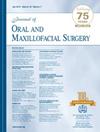不同内固定策略治疗双下颌骨折的结果:系统回顾和荟萃分析。
IF 2.6
3区 医学
Q2 DENTISTRY, ORAL SURGERY & MEDICINE
引用次数: 0
摘要
背景:双下颌骨折(DMF)的生物力学是复杂的,关于固定要求的文献是多种多样的。本研究的目的是估计DMF治疗后并发症的发生率,并确定这种发生率是否因所采用的固定策略而变化。方法:根据系统评价和元分析指南的首选报告项目进行系统评价和元分析。在PubMed, b谷歌Scholar, Semantic Scholar和Cochrane Library中进行了全面搜索,以确定2024年9月之前的DMF研究。包括随机对照试验(rct)、准对照试验和比较DMF固定方案的回顾性研究。排除体外或动物研究。预测变量是固定类型(非刚性、刚性和混合型),结果变量是错颌合、伤口感染、伤口裂开和硬体失效。偏倚风险评估采用乔安娜布里格斯研究所的关键评估清单和随机对照试验的偏倚风险2.0通用数据集。meta分析采用随机效应模型计算合并患病率,使用Stata (v.16)计算95% CI。结果:最初的搜索确定了2108篇出版物。应用纳入/排除标准后,最终样本由11项研究和1,747例病例组成。荟萃分析显示,硬体故障的总患病率为3% (95% CI: 2 - 6%),错牙合的总患病率为3% (95% CI: 1 - 7%),伤口开裂的总患病率为3% (95% CI: 2 - 5%),感染的总患病率为4% (95% CI: 2 - 8%)。非刚性固定组并发症发生率为4 ~ 6% (95% CI: 0.01 ~ 0.05, P = 0.1),刚性固定组为8 ~ 12% (95% CI: 0.01 ~ 0.05, P = 0.3),混合固定组为2 ~ 3% (95% CI: 0.01 ~ 0.05, P = 0.1),亚组差异无统计学意义。回顾性研究的偏倚风险低(n = 6),高(n = 1),而随机对照试验(n = 4)存在偏倚。结论:本荟萃分析表明,无论固定方式如何,DMF的总并发症发生率在3%至4%之间,固定方式对术后并发症发生率没有统计学意义。需要进一步精心设计的试验来证实这些发现。本文章由计算机程序翻译,如有差异,请以英文原文为准。
Outcomes of Different Internal Fixation Strategies for Double Mandibular Fractures: A Systematic Review and Meta-analysis
Background
The biomechanics of double mandibular fracture (DMF) is complex, and the literature on the fixation requirements is varied. The purpose of the study was to estimate the prevalence of complications following the management of DMF and to determine whether this prevalence varies based on the fixation strategy used.
Methods
A systematic review and meta-analysis was conducted following the Preferred Reporting Items for Systematic Reviews and Meta-Analyses guidelines. A comprehensive search was conducted in PubMed, Google Scholar, Semantic Scholar, and Cochrane Library to identify DMF studies until September 2024. Randomized controlled trials (RCTs), quasicontrolled trials, and retrospective studies comparing fixation schemes for DMF were included. In-vitro or animal studies were excluded. The predictor variable was the type of fixation (nonrigid, rigid, and mixed), and outcome variables were malocclusion, wound infection, wound dehiscence, and hardware failure. The risk of bias was assessed using the Joanna Briggs Institute (JBI) checklist for critical appraisal and the Risk of Bias 2.0 generic dataset for RCTs. Meta-analysis was conducted to calculate the pooled prevalence by random effects model with a 95% CI using Stata (v.16).
Results
The initial search identified 2,108 publications. After applying inclusion/exclusion criteria, the final sample was composed of 11 studies and 1,747 cases. The meta-analysis indicated pooled prevalence of 3% (95% CI: 2 to 6%) for hardware failure, 3% (95% CI: 1 to 7%) for malocclusion, 3% (95% CI: 2 to 5%) for wound dehiscence and 4% (95% CI: 2 to 8%) for infection.
Complication rates were 4 to 6% (95% CI: 0.01 to 0.05, P = .1) in the nonrigid fixation group, 8 to 12% (95% CI: 0.01 to 0.05, P = .3) in the rigid fixation group, and 2 to 3% (95% CI: 0.01 to 0.05, P = .1) in the mixed fixation group, with no statistically significant subgroup differences. The risk of bias was low (n = 6) and high (n = 1) in retrospective studies, while RCTs (n = 4) showed some bias.
Conclusion
This meta-analysis suggests that the overall complication rate for DMF ranges from 3 to 4%, regardless of the fixation method, and that the type of fixation does not have a statistically significant impact on postoperative complication rates. Further well-designed trials are needed to confirm these findings.
求助全文
通过发布文献求助,成功后即可免费获取论文全文。
去求助
来源期刊

Journal of Oral and Maxillofacial Surgery
医学-牙科与口腔外科
CiteScore
4.00
自引率
5.30%
发文量
0
审稿时长
41 days
期刊介绍:
This monthly journal offers comprehensive coverage of new techniques, important developments and innovative ideas in oral and maxillofacial surgery. Practice-applicable articles help develop the methods used to handle dentoalveolar surgery, facial injuries and deformities, TMJ disorders, oral cancer, jaw reconstruction, anesthesia and analgesia. The journal also includes specifics on new instruments and diagnostic equipment and modern therapeutic drugs and devices. Journal of Oral and Maxillofacial Surgery is recommended for first or priority subscription by the Dental Section of the Medical Library Association.
 求助内容:
求助内容: 应助结果提醒方式:
应助结果提醒方式:


